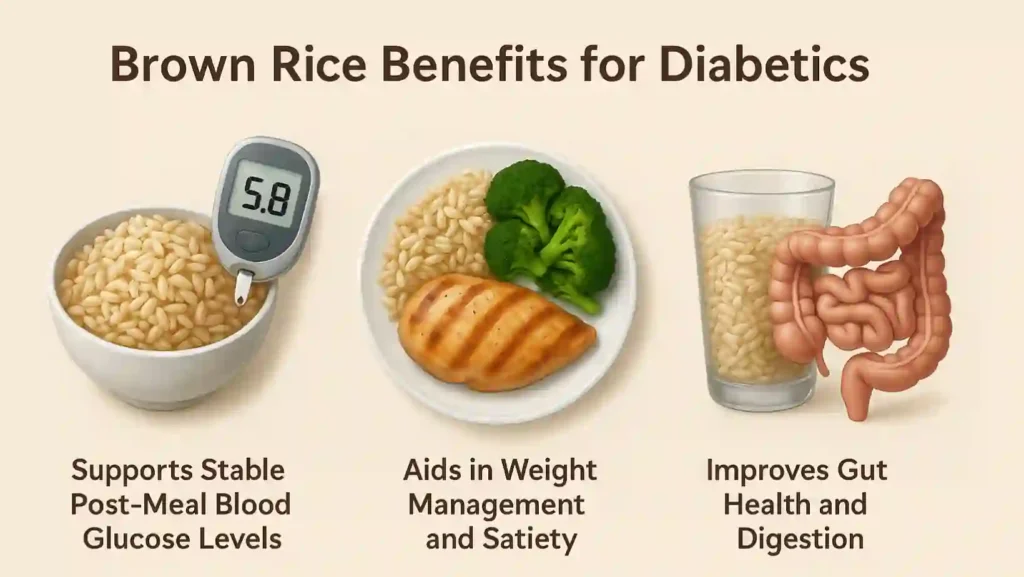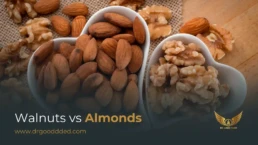Brown rice for diabetes can be a healthier choice than white rice for many people with diabetes when you watch portion size and meal balance. Brown rice keeps the bran and germ. That adds fiber, B vitamins, magnesium, and plant compounds.
Table of Contents
ToggleThese slow down digestion and reduce how fast glucose enters your blood. Still, brown rice is not a cure. You must pair it with protein, vegetables, and proper portion control to keep glucose steady.
Is Brown Rice Good For Diabetics?
Yes, often. You should treat brown rice for diabetes as a useful tool. Whole grains like brown rice tend to raise blood sugar more slowly than refined grains. This leads to lower and steadier post-meal blood glucose. Choose long-grain or basmati brown rice for a milder effect on blood sugar. If you have digestive issues, ask your clinician before changing grains.
Brown Rice Has A Lower Glycemic Index Than White Rice
Brown rice usually has a lower glycemic index than white rice. That means your blood sugar rises more slowly after you eat it. The actual number varies with rice type and cooking. Long-grain brown rice and basmati often score lower than short-grain rice. This makes brown rice for diabetes a smarter swap than white rice in many meals.
The Role Of Fiber And Complex Carbs In Blood Sugar Control
Fiber in brown rice slows digestion. Complex carbohydrates break down into sugar more slowly. Together, they reduce sharp glucose spikes. That improves how you feel after meals. Adding beans or lentils to rice increases fiber and protein. That gives stronger blood sugar control than rice alone.
Whole-Grain Rice Helps Improve Insulin Sensitivity
Regular whole-grain intake is linked to better insulin response in many studies. Substituting whole grains for refined grains can lower fasting glucose in some people. This effect is stronger when weight drops with a diet change. So brown rice for diabetes can help insulin sensitivity as part of a wider plan.
Why Portion Size Is The Key To Balance
Even healthy grains raise blood glucose if you eat too much. A sensible portion keeps carbohydrate grams in your target range. That protects you from big glucose swings and helps insulin work predictably. Always measure cooked rice, not dry rice, when counting portions.
Brown Rice Nutrition Facts For Diabetes
Brown rice keeps the outer bran and the germ. This keeps more vitamins and minerals than white rice. Typical nutrients that help people with diabetes include fiber, magnesium, and B vitamins.
- Fiber. Slows digestion and eases glucose rise.
- Magnesium. Supports glucose use in cells.
- B Vitamins. Help process energy from food.
- Plant compounds. Offer mild antioxidant effects.
A cooked cup of brown rice contains about 3 to 5 grams of fiber and useful amounts of magnesium and B vitamins. Exact numbers vary by variety. These nutrients support steady blood sugar when you eat rice sensibly.
brown rice diabetes nutrition
Nutrient Profile: Fiber, B Vitamins, And Magnesium
You get several benefits from the bran and germ:
- Fiber (soluble and insoluble) helps slow carbohydrate digestion.
- Thiamine and niacin are B vitamins that support carbohydrate metabolism.
- Magnesium helps with insulin action and glucose control.
These nutrients make brown rice for diabetes more than empty calories. They help your body handle a meal better than a refined grain would.
Brown Rice Vs White Rice Nutrition Comparison
Brown rice keeps the whole grain kernel. White rice removes bran and germ. That removes most fiber and many minerals. White rice may be enriched with some vitamins later, but enrichment does not replace fiber or magnesium. For most people, brown rice for diabetes gives more nutritional value per serving than white rice.
How Fiber Slows Glucose Absorption
Fiber creates a physical barrier in your gut. Enzymes take longer to access starch. Glucose enters your blood more slowly. This leads to a lower peak in blood sugar after eating. Combine rice with vegetables and protein to strengthen this effect. That helps you keep glucose within your target range.
Brown Rice’s Role In Cholesterol And Heart Health
Whole grains help manage cholesterol. Eating brown rice regularly is linked to lower LDL cholesterol in population studies. Since cardiovascular risk is higher in people with diabetes, choosing whole grains like brown rice supports both blood sugar and heart health.
Brown Rice Benefits For Diabetics
Supports Stable Post-Meal Blood Glucose Levels
When you choose brown rice for diabetes, you favor slower digestion. That often translates into smaller post-meal blood sugar rises. This is most effective when you:
- Keep portions small.
- Add protein and vegetables.
- Avoid sugary sauces.
Aids In Weight Management And Satiety
Fiber in brown rice increases fullness after a meal. Feeling full helps you eat less later. Lower calorie intake can support weight loss. Weight loss often improves blood sugar control. That is one reason brown rice for diabetes helps indirectly with glucose management.
Improves Gut Health And Digestion
Fiber feeds helpful gut bacteria. Better gut balance supports digestion. It can also reduce constipation. Healthy gut flora may influence metabolism in ways that help glucose control over time.
Reduces Risk Of Type 2 Diabetes And Insulin Resistance
Whole grains are linked to a lower risk of type 2 diabetes. Brown rice is a whole grain. When you choose it often, your body may handle insulin better over time. The fiber slows glucose release.
Magnesium helps cells use insulin. This makes brown rice for diabetes a solid grain choice when you want better long-term stability. Studies show that people who eat more whole grains tend to have lower fasting glucose than people who rely on refined grains.
Boosts Antioxidant Protection And Reduces Inflammation
Brown rice holds plant compounds that act like mild antioxidants. These protect cells from stress. Lower stress inside cells helps reduce inflammation. People with diabetes deal with more inflammation than people without diabetes. Lowering it may support smoother glucose control and may help heart health.
How Much Brown Rice Can Diabetics Eat?
Recommended Portion: ½ to 1 Cup Cooked Per Meal
A safe place to start is half to one cup of cooked brown rice per meal. This keeps carbs steady without overloading your plate. You can adjust based on your blood sugar targets. Using this serving size helps you enjoy brown rice for diabetes without big glucose spikes.
Pair With Proteins And Vegetables For Better Glucose Control
Never eat rice alone. Your blood sugar will rise faster if you do. Add protein like fish, eggs, chicken, tofu, or beans. Add vegetables like spinach, broccoli, or carrots. These slow down digestion and help you stay full longer. Many people notice lower glucose numbers when they pair rice with protein at every meal.
How Timing And Meal Composition Affect Glycemic Response
Eat brown rice during a balanced meal. Eating it by itself may push glucose up fast. If you walk for ten to fifteen minutes after eating, your muscles use glucose. This helps your post-meal glucose drop more smoothly. If you take insulin, talk to your clinician about timing so you match insulin with carb intake.
Brown Rice And Glycemic Index (GI)
GI Value Of Brown Rice Vs White Rice Explained
Brown ric if you want a lower GI e often reaches the mid-range on the GI scale. White rice usually sits higher. A higher GI means glucose rises faster. A lower GI means smoother control. This is why brown rice for diabetes fits better for many people. Long grain and basmati brown rice are usually the best options if you want a lower GI.
Factors That Affect Glycemic Load
Glycemic load depends on more than GI. Cooking style matters. Portion size matters. A small serving of a high GI food can have a lower load than a large serving of a low GI food. Cooling rice increases resistant starch. This lowers the load. Eating protein with rice lowers the whole meal load.
Why Reheated Or Cooled Rice Lowers GI
When rice cools, some starch changes form. This creates resistant starch. Your body digests resistant starch very slowly. When you reheat cooled rice, it keeps some of that resistant starch. This lowers the glucose rise. If you want stronger glucose control, cook rice ahead and chill it before reheating.
How To Cook Brown Rice For Better Blood Sugar Control
Opt For Boiled Or Steamed Rice Instead Of Fried
Boiled or steamed rice gives cleaner carbs without extra fat. Fried rice adds oil and sauces. Some sauces contain sugar. These can push glucose higher after meals. Keep your cooking simple to control calories and carbs.
Avoid Excess Oil Or Butter Additions
Oil and butter raise calorie intake. They do not help with blood sugar if used in large amounts. Use small amounts of healthy fat like olive oil for flavor, not for bulk. Too much added fat may affect weight.
Combine With Lentils, Beans, Or Leafy Greens
Pair brown rice with lentils, beans, or greens. This improves the nutrient profile. Fiber rises. Protein rises. This creates slower glucose release. Many people who try a lentil and brown rice mix notice milder post-meal glucose spikes.
Choose Long-Grain Or Basmati Brown Rice For Lower GI
Short-grain rice digests faster. That can raise glucose quickly. Long-grain or basmati brown rice digests more slowly. The starch structure is different. This helps people who want better glucose control. Choose these forms of brown rice for diabetes as your main grains whenever possible.
Whole Grain Rice And Diabetes Control
Why Whole Grains Are Better For Long-Term Glucose Balance
Whole grains raise glucose more slowly. They help your body handle insulin better over months. Eating whole grains also supports heart health. People with diabetes have a higher heart risk, so these grains offer more than blood sugar benefits.
Other Whole Grain Options: Quinoa, Oats, Barley
You do not need to rely on brown rice alone. Try quinoa for higher protein. Try oats for more soluble fiber. Try barley for stronger glucose-slowing effects. Rotating grains reduces arsenic exposure and supports gut health.
Switching Gradually From White Rice To Brown Rice
If you eat white rice every day, switch slowly. Mix brown and white in the same pot. Week one can be twenty-five percent brown. Week two can be half brown. Week three can be mostly brown. This helps your taste adapt. It also helps digestion adjust in a gentle way.
Impact Of Consistent Whole Grain Intake On HbA1c Levels
HbA1c shows average glucose over three months. Some people see slight HbA1c drops when they replace refined grains with whole grains. Results differ by person. Whole grains help most when used with weight control and steady meal patterns.
Brown Rice Vs White Rice: Which Is Better For Diabetics?
Nutritional And Glycemic Difference At A Glance
Brown rice holds fiber and minerals. White rice does not. That alone makes brown rice for diabetes more helpful for glucose control. Brown rice has a lower GI and more nutrients that support metabolic health. White rice digests faster and raises glucose more.
Why Brown Rice Offers More Minerals And Fiber
The bran contains magnesium, manganese, and B vitamins. Fiber also sits in the bran. When you remove the bran, you remove those nutrients. This is why white rice gives fewer benefits for blood sugar control.
When White Rice May Be Preferred
Some people cannot tolerate much fiber because of gut issues. Some older adults also struggle with high-fiber meals. In these cases, a small portion of white rice may be easier on digestion. Although fiber helps, comfort and tolerance still matter.
How To Mix Both Safely In A Diabetic Meal Plan
Mixing grains can help with taste and texture. You can mix two parts brown rice with one part white rice. Meals still benefit from the fiber in brown rice. Keep portions measured and add protein.
Possible Disadvantages Of Brown Rice For Diabetes
Slightly Higher Carbs Per Cup So Portion Matters
One cooked cup of brown rice has meaningful carbs. This can push glucose up if the portion is too big. Always measure your serving. Stick to your carb limit for each meal.
May Contain Trace Arsenic, So Rinse And Soak Before Cooking
Brown rice may contain more arsenic than white rice because arsenic gathers in the bran layer. Rinse rice well. Soak it for a few hours. Cook it in excess water and drain it. This lowers arsenic. Rotate grains like oats and quinoa to reduce exposure.
Not Suitable For Very Low Carb Diets
Very low-carb diets do not allow grains. Brown rice will not fit into these plans. If you follow a strict low-carb pattern, talk to your clinician about safe carb choices.
Brown Rice Meal Ideas For Diabetics
You can use brown rice in many simple meals.
- Brown rice with grilled fish and steamed broccoli.
- Brown rice stir fry with tofu and leafy greens.
- Lentil and brown rice mix for more fiber.
- Brown rice salad with beans, lemon, and avocado.
These meals keep you full and support glucose control. They help you use brown rice for diabetes without risking large spikes.
Brown Rice And Diabetes: Expert Nutrition Tips
Eat smaller meals spread across the day if that keeps glucose steady. Always add protein to grains. Drink water to support digestion. Track your total carb intake even when using healthy grains. If you plan big diet changes, speak with a dietitian first.
FAQs
Is brown rice good for people with type 2 diabetes?
Brown rice can help people with type 2 diabetes because it raises glucose more slowly than white rice and provides fiber that helps steady blood sugar during meals.
How much brown rice can a diabetic eat daily?
Most people can eat half to one cup of cooked brown rice per meal. The safe amount depends on your carb targets and how your blood sugar responds to meals.
Can brown rice raise blood sugar levels?
Brown rice can still raise blood sugar because it contains carbs, but it does so more slowly than white rice when you watch portion size and pair it with protein and vegetables.
Which type of brown rice is best for diabetes?
Long grain and basmati brown rice work best because they digest more slowly and usually have lower glycemic index scores compared to short grain options.
Does brown rice help reduce insulin resistance?
Brown rice may support lower insulin resistance when used with weight control, steady eating patterns, and fewer refined grains in your daily meals.
Is it okay to eat brown rice every day?
It is usually safe to eat brown rice daily if you rinse it well, keep your portions small, rotate other grains often, and monitor how your blood sugar reacts after meals.
Can brown rice help manage weight in diabetes?
Brown rice helps with weight because its fiber increases fullness and reduces hunger, which makes it easier to cut calories and manage blood sugar in daily meals.
What is the difference between brown and parboiled rice?
Parboiled rice is steamed before milling, so it keeps some nutrients. Brown rice keeps the full bran layer, which gives it more fiber and minerals for glucose control.
Should diabetics soak brown rice before cooking?
Soaking brown rice can reduce cooking time, improve texture, and lower some arsenic content, which helps people who want safer and more steady meal choices.
Can brown rice be eaten with other carbs?
You can eat brown rice with other carbs if you track your total intake and keep portions small so your total carbohydrate load stays in your target range per meal.
How does brown rice compare with quinoa for diabetics?
Quinoa has more protein and may raise glucose more slowly. Brown rice offers more fiber than white rice. Both can fit into a healthy meal plan for diabetes.
What are the best times to eat brown rice for stable sugar levels?
Brown rice works best when eaten during balanced meals that include protein and vegetables, followed by light activity that helps reduce rises in blood sugar.
Does cooling brown rice reduce its glycemic load?
Cooling brown rice increases resistant starch, which slows digestion and can lower the blood sugar rise, even after you reheat the rice before eating it.
Can brown rice be part of a low-carb diabetes plan?
Brown rice is not ideal for strict low-carb plans, but small servings can fit into moderate carb plans if you stay within your daily carb goals.

This article is medically reviewed by Dr. Nivedita Pandey, Senior Gastroenterologist and Hepatologist, ensuring accurate and reliable health information.
Dr. Nivedita Pandey is a U.S.-trained gastroenterologist specializing in pre and post-liver transplant care, as well as managing chronic gastrointestinal disorders. Known for her compassionate and patient-centered approach, Dr. Pandey is dedicated to delivering the highest quality of care to each patient.









